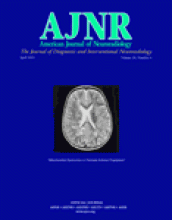Recent advances in the imaging of water diffusion have led to the development of diffusion tensor imaging (DTI) (1–3), which uses the properties of water diffusion to provide information about the integrity, location and orientation of white-matter tracts in brain. DTI presents an exciting new opportunity not only for examining brain microstructure in various disease states, but also for studying functional connectivity.
DTI exploits the fact that diffusion of water molecules in white matter is constrained, or anisotropic, moving preferentially along the primary axes of fiber tracts. Diffusion tensor data are represented in each voxel as a 3D ellipsoid, reflecting the rate of diffusion along the ellipsoid’s three principal axes. Voxels along fiber pathways tend to form lines along these pathways. By connecting the long axis of each ellipsoid between given starting and end positions, one can trace the structure of fiber tracts.
There are several problems associated with quantitative DTI tractography which need addressing before fiber tractography becomes a clinical reality. For instance, there is no reference standard yet for in vivo tractography. DTI requires extensive computing power, man-hours, and expertise. DTI also suffers from the same artifacts and limitations associated with acquiring DWI data, including motion artifact-induced ghosting, eddy current misregistration errors, and signal intensity loss due to susceptibility variations.
In the March issue of the AJNR, Chou et al (4) address an important aspect of susceptibility artifact in DT tractography by investigating the effects of CSF suppression by using FLAIR in normal adult brains. Drawing on the experience of DWI studies, they compare diffusion tractography incorporating FLAIR with DT tractography based on conventional spin-echo echo-planar technique. Several DWI studies have already shown that partial volume effects from CSF result in overestimation of ADC and underestimation of diffusion anisotropy in regions prone to partial volume effects. Many of these same studies also show that suppressing CSF signals by incorporating FLAIR eliminates many of the inaccuracies in ADC and anisotropy measurements in susceptible brain regions (5–7).
The authors hypothesize that diffusion-tensor tractography might benefit from CSF suppression in susceptible brain regions since fractional anisotropy measurements also show improvement. Fiber tracking algorithms are however strongly dependent on SNR, which is diminished with FLAIR. Therefore, the premise of Chou et al’s study is to investigate whether there is any net benefit in incorporating FLAIR into DTI fiber tracking, since the benefits from improved anisotropy measurements may be offset by loss of SNR.
In their study, Chou et al demonstrate a clear advantage in using CSF suppression for detecting fiber tract volume in periventricular regions. What remains to be determined, however, is whether the loss in SNR with FLAIR limits tractography in regions relatively free of CSF contamination. Whereas SNR is not as important in the calculation of diffusion coefficient values with conventional DWI, it is perhaps the most important determinate in fiber tracking, aside from anisotropy measurements.
The incorporation of CSF suppression for tractography may ultimately be used in a situation-specific manner, depending on the specific research or clinical question at hand. Chou et al’s thorough study presents a first convincing argument for the role of CSF suppression in tractography involving periventricular pathways. It will be important to learn whether CSF suppression limits or facilitates tractography in other brain regions likely to be involved in various disease states, injury, aging, and functional studies.
- American Society of Neuroradiology












